
95% of researchers rate our articles as excellent or good
Learn more about the work of our research integrity team to safeguard the quality of each article we publish.
Find out more
ORIGINAL RESEARCH article
Front. Soil Sci. , 13 October 2022
Sec. Soil Pollution & Remediation
Volume 2 - 2022 | https://doi.org/10.3389/fsoil.2022.1020814
The microbial population (MP) is considered to be a relatively important part of soil health, quality, and productivity. Therefore, this study aimed to access the effects of tillage and rice cultivation modes on soil MP in Stagnic Anthrosols and Lateritic Red Earth soils. The treatments were as follows: (i) MDS: land tilled twice with a moldboard plow and hill-seeding of pregerminated seeds with a direct seeding machine of four to six seeds per hill at a planting space of 25 × 15 cm, (ii) RDS: land tilled twice with a rotary tiller and hill-seeding of pregerminated seeds with a direct seeding machine of four to six seeds per hill at a planting space of 25 × 15 cm, (iii) MMT: land tilled twice with a moldboard plow and 15-day-old seedlings were mechanically transplanted with a transplanting machine at a transplanting hill of four to six seedlings and at a transplanting space of 25 × 15 cm, and (iv) RMT: land tilled twice with a rotary tiller and 15-day-old seedlings were mechanically transplanted with a transplanting machine at a transplanting hill of four to six seedlings and a transplanting space of 25 × 15 cm. The findings showed that MDS improved the MP and increases rice yield. MDS showed a high increase in MP in both locations and the rice productivity of 32.81% (1H; first harvest) and 13.91% (2H; second harvest) and 16.48% (1H) and 18.13% (2H) for Zeng-Cheng and Yi-Yang, respectively. In conclusion, MDS was found to be better in improving the MP and increasing rice yield and could be adopted as a suitable approach for improving soil health, quality, and productivity.
Soil microbes are vital for the development of soil fertility, maintenance of food security, and mitigation of climate change. As the living portion of soil organic matter, soil microbes play an important role in the function of ecosystems through their complex interactions with the environment (1, 2). These functions include organic matter decomposition and nutrient cycling, including carbon (C) and nitrogen (N) cycling (2–4), and soil aggregate formation and maintenance (5). Furthermore, the microbial population (MP) size and diversity in agricultural soils can be affected by soil management practices. Agricultural land management is one of the most significant anthropogenic activities that alter the soil characteristics, including physical, chemical, and biological property processes. Previous studies have shown that microbial biomass can be altered by changes in agricultural management practices (6–15). Microbial indicators such as enzyme activities are good potential indices of soil quality and health because of their role in soil biological and biochemical processes, ease of measurement, and rapid response to changes in soil quality induced by the management (14). Appropriate tillage combined with the right cultivation mode of rice on paddled fields can have a thorough impact on the soil MP and rice yield, as an improvement in rice yield is a result of the enhancement of soil microbes and also reduces the strenuous ways of seedling transplanting in paddy fields. The aim of the present study was to investigate the effects of different tillage and rice cultivation modes on soil MP (bacteria, fungi, actinomycete, catalase, urease, and phosphatase) and on rice yield.
An experiment was established at Zeng-Cheng in Guangdong Province of Southern China (23°13′ N, 113°81′ E, altitude 11 m, Figure 1A) and Yi-Yang in Hunan Province of Southern China (29°07′40″ N, 112°25′25″ E, 27 m in altitude, Figure 1B) for two seasons (2017 and 2018). The meteorological data of the crop seasons are given in Table 1. The soil under experimentation was sandy-loam and sandy-clay-loam for Zeng-Cheng and Yi-Yang, respectively. The soils of the study sites are classified as Stagnic Anthrosols for Zeng-Cheng and Lateritic Red Earth for Yi-Yang, which developed from the Quaternary Red Earth (16). The Zeng-Cheng site had N, P, and K content of 39.52, 13.32, and 31.19 kg ha-1, respectively, with a pH value of 5.65, and Yi-Yang had soil N, P, and K content of 100, 8.5, and 112 kg ha-1, respectively, with a pH value of 6.5. The pre-soil condition of the experimental sites is given in Table 2. Soil bacteria, fungi, and actinomycetes were determined by the plate inoculation method (17). Soil urease was determined by the automated calorimetric method (17). Soil catalase was determined by the volumetric method (17). Soil phosphatase was determined by the phenyl phosphate sodium colorimetric method (17).
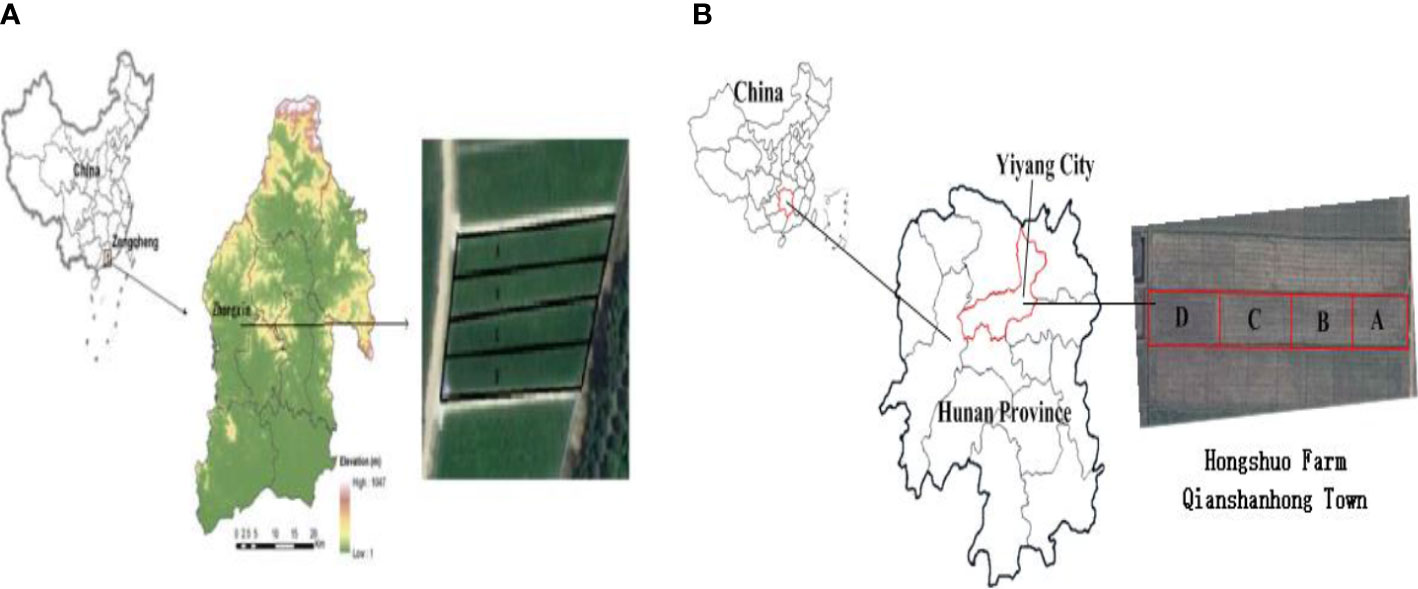
Figure 1 Site location of South China Agricultural University Research Station: (A) Zhongxi Town, Zeng-Cheng District, Guangzhou City, Guangdong Province, China, and (B) Yi-Yang City, Hunan Province, China.
Four cultivation modes, viz., (i) MDS: land tilled twice with a moldboard plow (at 30 cm depth) and hill-seeding of pregerminated seeds with a direct seeding machine of four to six seeds per hill at a planting space of 25 × 15 cm, (ii) RDS: land tilled twice with a rotary tiller (at 30-cm depth) and hill-seeding of pregerminated seeds with a direct seeding machine of four to six seeds per hill at a planting space of 25 × 15 cm, (iii) MMT: land tilled twice with a moldboard plow (at 30-cm depth) and 15-day-old seedlings were mechanically transplanted with a transplanting machine at a transplanting hill of four to six seedlings and at a transplanting space of 25 × 15 cm, and (iv) RMT: land tilled twice with a rotary tiller (at 30-cm depth) and 15-day-old seedlings were mechanically transplanted with a transplanting machine at a transplanting hill of four to six seedlings and a transplanting space of 25 × 15 cm. The experimental field measured 10,990 m2, with subdivided plots: MDS and RDS (100 m × 35 m) and MMT and RMT (57 m × 35). Aromatic rice cultivar Meixiangzhan-2 and Huanghuazha, respectively, for Zeng-Cheng and Yi-Yang, with a maturity period between 111 and 114 days, were sown through direct hill drop method by 2BDCSP Precision Rice Hill-Drop Drilling Machine and transplanted by YANMAR VP7D25 Rice Transplanter. The first harvest (H1) was done in August 25 and August 18, respectively, in 2017 and 2018, and the second harvest (H2) was done in October 20 in 2017 and 2018 at both locations.
Rice grains were harvested at maturity from three-unit sampling areas (1.00 m2) randomly selected in each plot and then machine-threshed at both farm sites. The harvested grains were sun-dried at 13.5% moisture content and weighted in order to determine the grain yield. FUQIANG 4LZ-427 Full-Fill Grain Combine Harvester was used to harvest the whole rice fields.
Statistical analysis was conducted using IBM SPSS software 23.0 (SPSS Inc., Chicago, IL, USA). Duncan’s multiple range test at 5% probability was performed to compare the means of different treatments.
Culturable bacteria at 0–30-cm depth were highest under MDS (2.55 × 105 cfu·g-1 dry soil), followed by RDS (2.40 × 105 cfu·g-1 dry soil), MMT (2.22 × 105 cfu·g-1 dry soil), and RMT (1.88 × 105 cfu·g-1 dry soil) during 1H and MDS (2.77 × 105 cfu·g-1 dry soil), followed by RDS (2.57 × 105 cfu·g-1 dry soil), MMT (2.37 × 105 cfu·g-1 dry soil), and RMT (1.79 × 105 cfu·g-1 dry soil) during 2H for Zheng-Cheng as shown in Figure 2. Similar trends were recorded for bacteria at 0–30-cm depth, with MDS (2.85 × 105 cfu·g-1 dry soil), followed by RDS (2.65 × 105 cfu·g-1 dry soil), MMT (2.34 × 105 cfu·g-1 dry soil), and RMT (1.82 × 105 cfu·g-1 dry soil) during 1H and MDS (2.08 × 105 cfu·g-1 dry soil), followed by RDS (1.73 × 105 cfu·g-1 dry soil), RMT (1.27 × 105 cfu·g-1 dry soil), and MMT (0.71 × 105 cfu·g-1 dry soil) during 2H for Yi-Yang as shown in Figure 2.
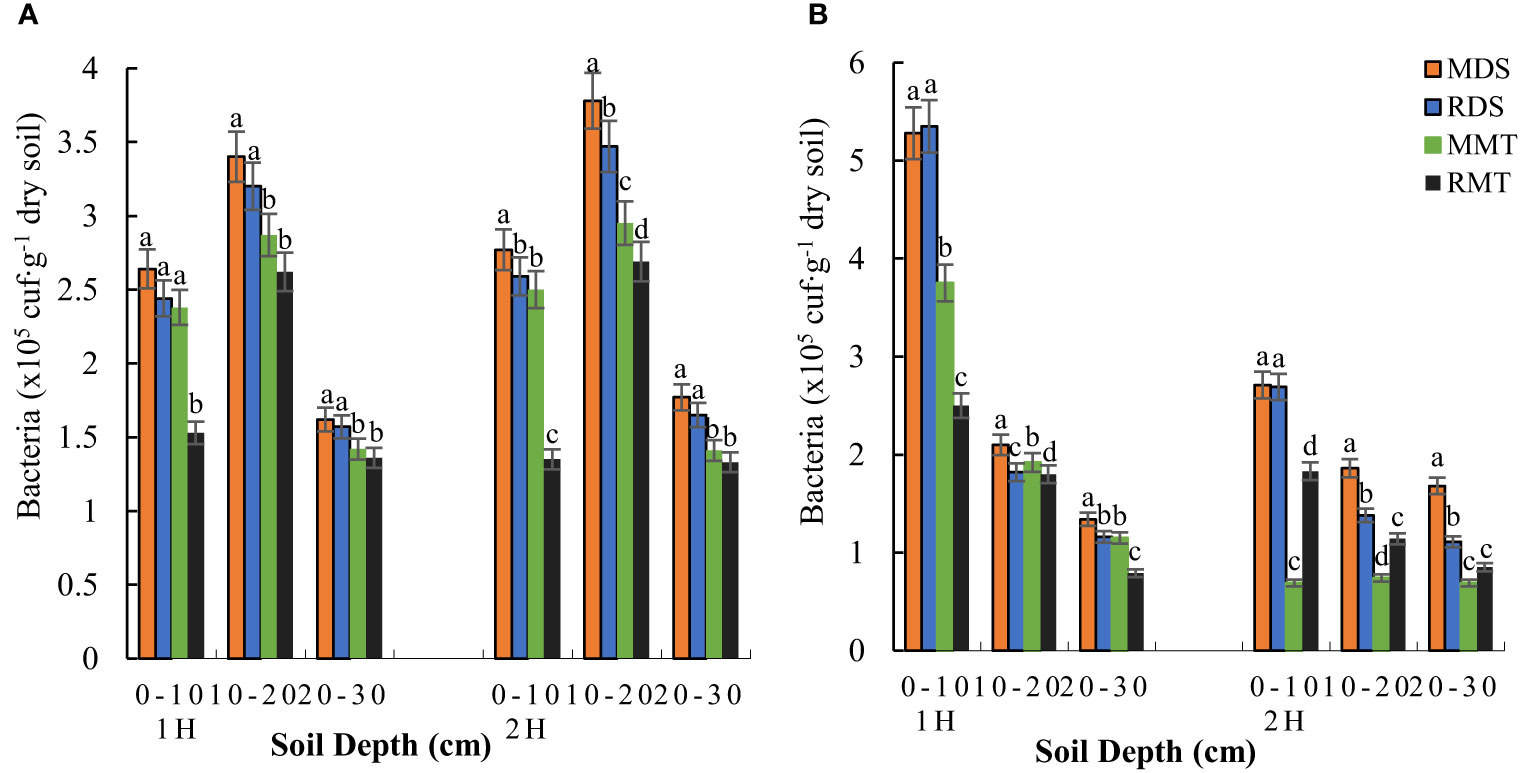
Figure 2 Tillage and rice cultivation modes on culturable bacteria population: (A) Zeng-Cheng and (B) Yi-Yang. MDS, land tilled twice with a moldboard plow and hill-seeding of pregerminated seeds with a direct seeding machine; RDS, land tilled twice with a rotary tiller and hill-seeding of pregerminated seeds with a direct seeding machine; MMT, land tilled twice with a moldboard plow and 15-day-old seedlings were mechanically transplanted with a transplanting machine; RMT, land tilled twice with a rotary tiller and 15-day-old seedlings were mechanically transplanted with a transplanting machine. Figures in the column with common letter(s) do not differ significantly at the 5% level of Duncan’s multiple range text. 1H, first harvest; 2H, second harvest.
The soil culturable fungi (at 0–30-cm depth) under tillage and different cultivation modes were highest under MDS (1.64 × 103 cfu·g-1 dry soil), followed by RDS (1.47 × 103 cfu·g-1 dry soil), MMT (1.42 × 103 cfu·g-1 dry soil), and RMT (1.34 × 103 cfu·g-1 dry soil) during 1H and MDS (1.76 × 103 cfu·g-1 dry soil), followed by MMT (1.47 × 103 cfu·g-1 dry soil), RMT (1.40 × 103 cfu·g-1 dry soil), and RDS (1.26 × 103 cfu·g-1 dry soil) during 2H for Zheng-Cheng as shown in Figure 3. Similar trends were recorded for bacteria at 0–30-cm depth, with MDS (0.24 × 103 cfu·g-1 dry soil), followed by RDS (0.19 × 103 cfu·g-1 dry soil), MMT (0.10 × 103 cfu·g-1 dry soil), and RMT (0.09 × 103 cfu·g-1 dry soil) during 1H and MDS (0.24 × 103 cfu·g-1 dry soil), followed by RDS (0.16 × 103 cfu·g-1 dry soil) and MMT and RMT (0.11 × 103 cfu·g-1 dry soil) during 2H for Yi-Yang as shown in Figure 3.
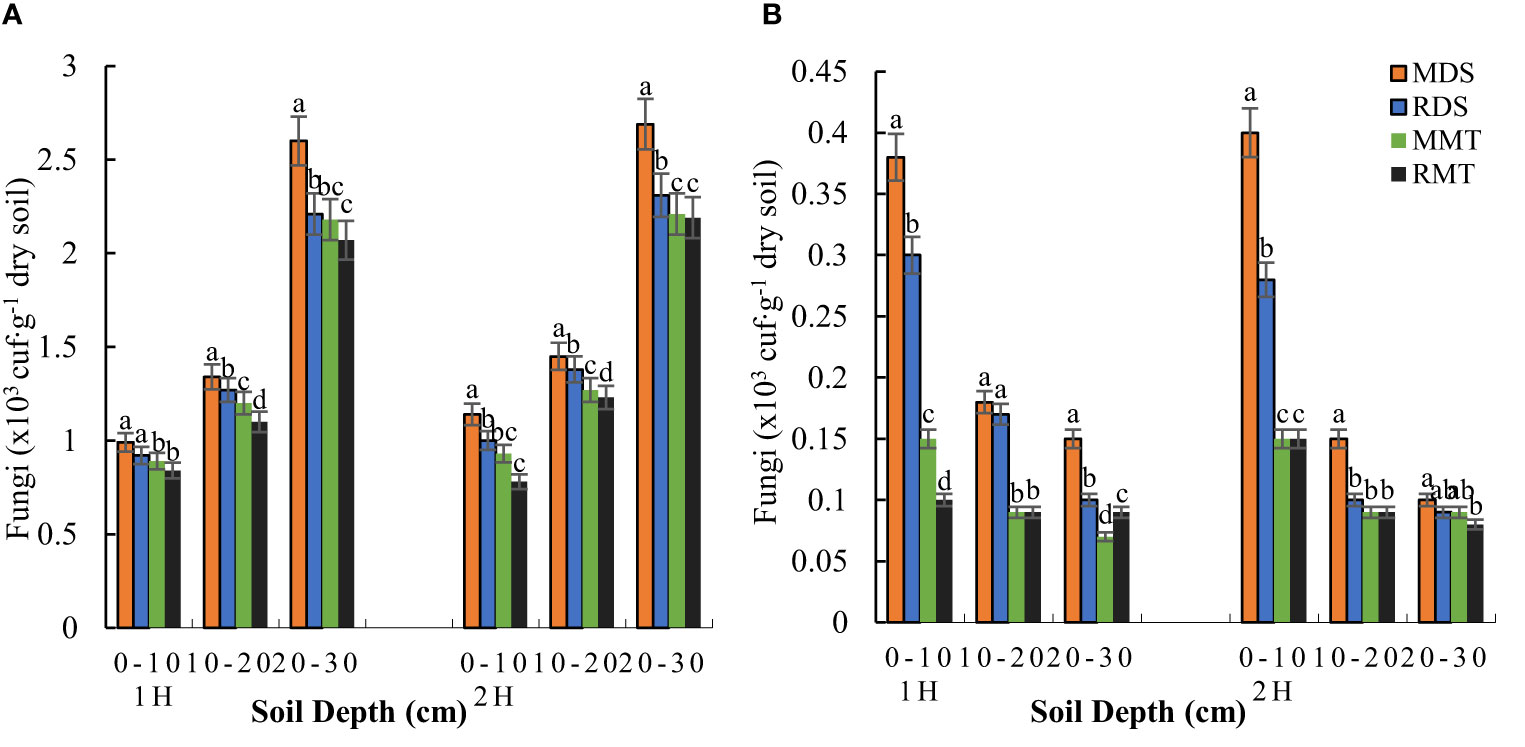
Figure 3 Tillage and rice cultivation modes on culturable fungi population: (A) Zeng-Cheng and (B) Yi-Yang. MDS, land tilled twice with a moldboard plow and hill-seeding of pregerminated seeds with a direct seeding machine; RDS, land tilled twice with a rotary tiller and hill-seeding of pregerminated seeds with a direct seeding machine; MMT, land tilled twice with a moldboard plow and 15-day-old seedlings were mechanically transplanted with a transplanting machine; RMT, land tilled twice with a rotary tiller and 15-day-old seedlings were mechanically transplanted with a transplanting machine. Figures in the column with common letter(s) do not differ significantly at the 5% level of Duncan’s multiple range text. 1H, first harvest; 2H, second harvest.
Culturable actinomycete populations at 0–30-cm depth were highest under MDS (3.19 × 104 cfu·g-1 dry soil), followed by RMT (3.16 × 104 cfu·g-1 dry soil), RDS (2.99 × 104 cfu·g-1 dry soil), and MMT (2.89 × 104 cfu·g-1 dry soil) during 1H and MDS (3.33 × 104 cfu·g-1 dry soil), followed by RDS (3.12 × 104 cfu·g-1 dry soil), MMT (3.04 × 104 cfu·g-1 dry soil), and RMT (2.98 × 104 cfu·g-1 dry soil) during 2H for Zheng-Cheng as shown in Figure 4. Similar trends were recorded for bacteria at 0–30-cm depth, with MDS (5.04 × 104 cfu·g-1 dry soil), followed by RDS (3.71 × 104 cfu·g-1 dry soil), RMT (2.77 × 104 cfu·g-1 dry soil), and MMT (2.24 × 104 cfu·g-1 dry soil) during 1H and MDS (5.72 × 104 cfu·g-1 dry soil), followed by RDS (5.30 × 104 cfu·g-1 dry soil) and MMT (4.62 × 104 cfu·g-1 dry soil) and RMT (4.42 × 104 cfu·g-1 dry soil) during 2H for Yi-Yang as shown in Figure 4.
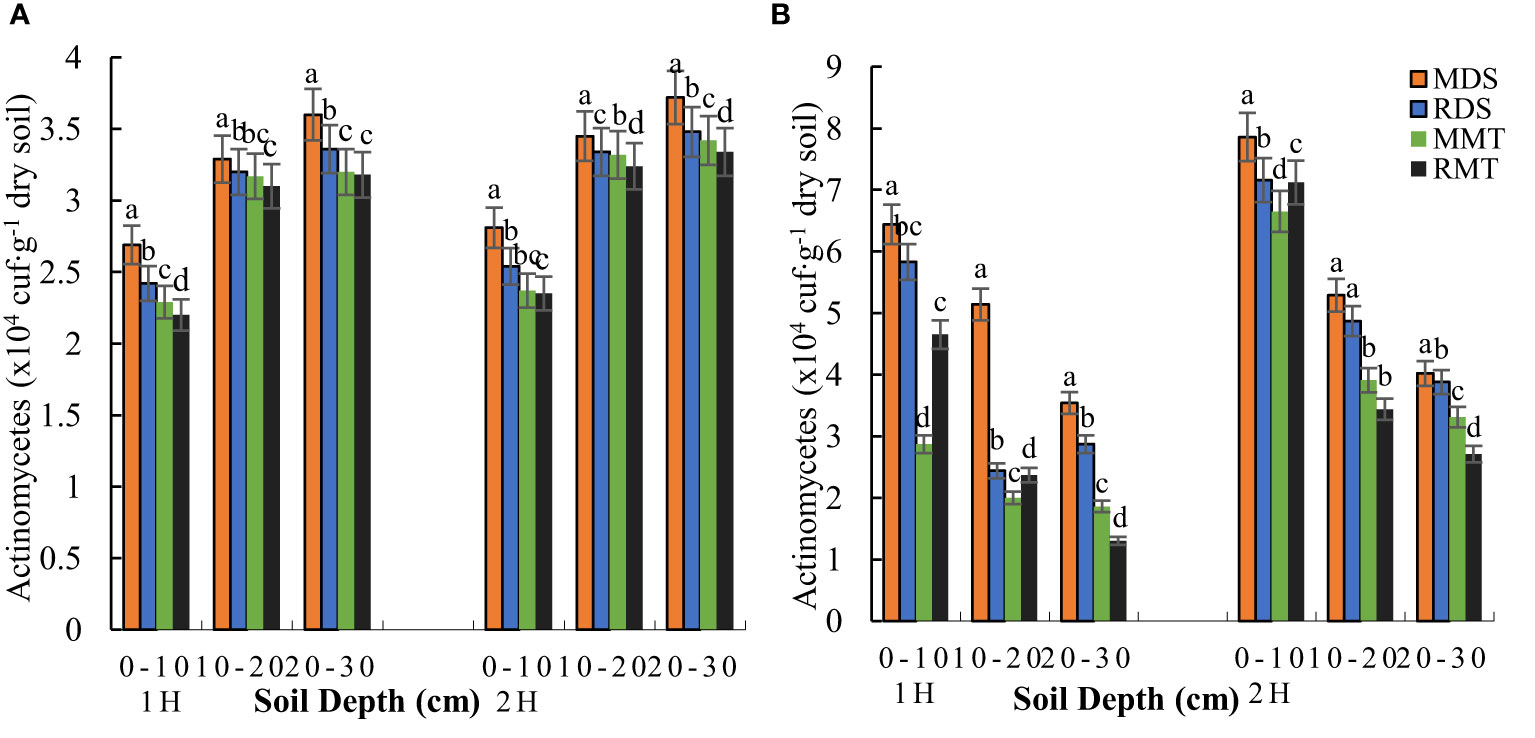
Figure 4 Tillage and rice cultivation modes on culturable actinomycetes population: (A) Zeng-Cheng and (B) Yi-Yang. MDS, land tilled twice with a moldboard plow and hill-seeding of pregerminated seeds with a direct seeding machine; RDS, land tilled twice with a rotary tiller and hill-seeding of pregerminated seeds with a direct seeding machine; MMT, land tilled twice with a moldboard plow and 15-day-old seedlings were mechanically transplanted with a transplanting machine; RMT, land tilled twice with a rotary tiller and 15-day-old seedlings were mechanically transplanted with a transplanting machine. Figures in the column with common letter(s) do not differ significantly at the 5% level of Duncan’s multiple range text. 1H, first harvest; 2H, second harvest.
Catalase activity at 0–30-cm depth was highest under MDS [1.72 (0.1 N KMnO4, ml·g-1)], followed by RDS [1.60 (0.1 N KMnO4, ml·g-1)], RMT [1.36 (0.1 N KMnO4, ml·g-1)], and MMT [1.07 (0.1 N KMnO4, ml·g-1)]) during 1H and MDS [1.71 (0.1 N KMnO4, ml·g-1)], followed by RDS [1.60 (0.1 N KMnO4, ml·g-1)], MMT [1.53 (0.1 N KMnO4, ml·g-1)], and RMT [1.46 [(0.1 N KMnO4, ml·g-1)] during 2H for Zheng-Cheng as shown in Table 3. Similar trends were recorded for bacteria at 0–30-cm depth, with MDS [45.85 (0.1 N KMnO4, ml·g-1)], followed by RDS [44.39 (0.1 N KMnO4, ml·g-1)], MMT [42.01 (0.1 N KMnO4, ml·g-1)], and RMT [40.44 (0.1 N KMnO4, ml·g-1)] during 1H and MDS [25.56 (0.1 N KMnO4, ml·g-1)], followed by RDS [24.72 (0.1 N KMnO4, ml·g-1)], MMT [22.55 (0.1 N KMnO4, ml·g-1)], and RMT [21.66 (0.1 N KMnO4, ml·g-1)] during 2H for Yi-Yang as shown in Table 3.
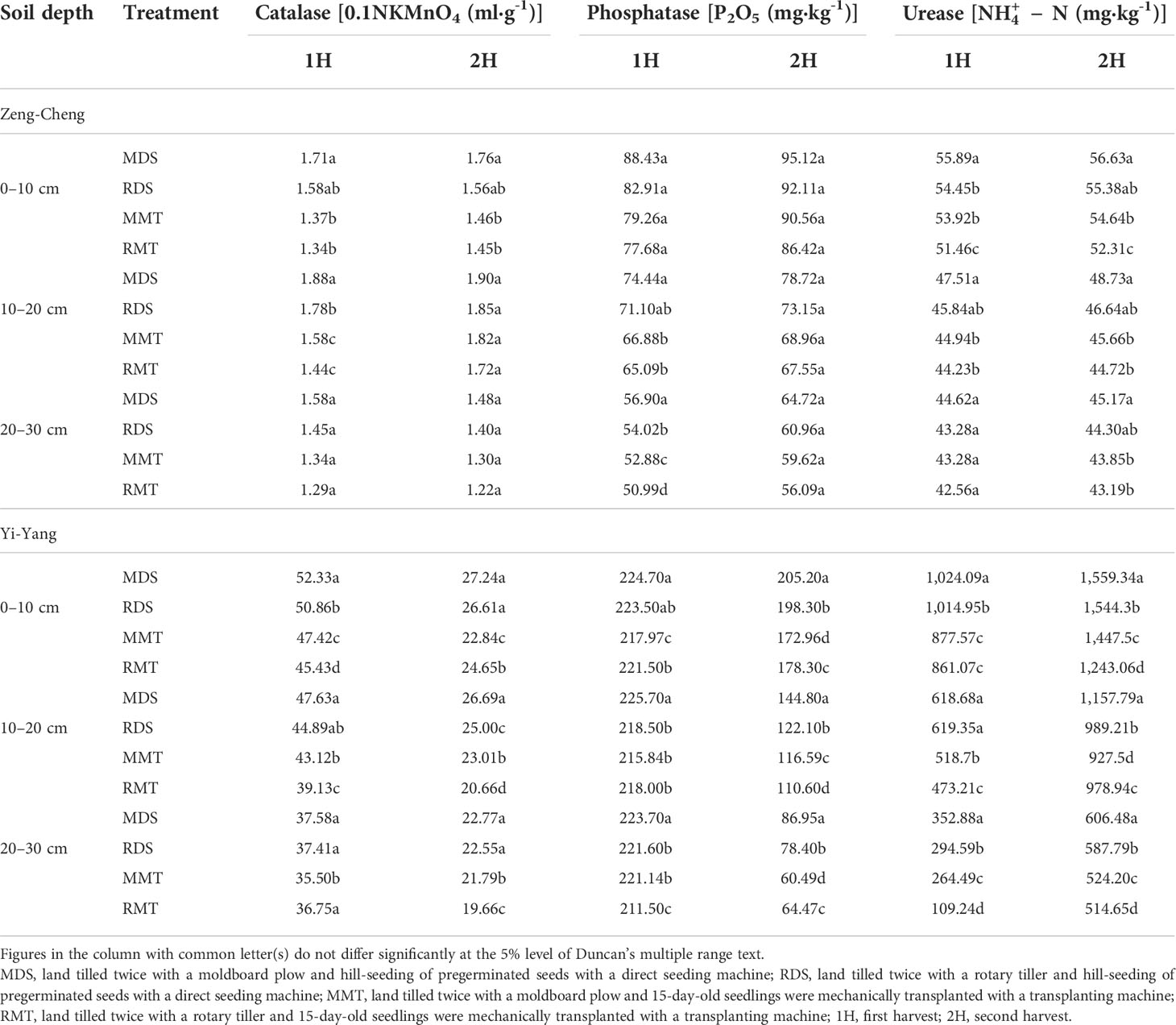
Table 3 Catalase, phosphatase, and urease activity as affected by tillage and rice cultivation modes.
The activity of phosphatase at 0–30-cm depth was highest under MDS [73.26 (P2O5, mg·kg-1)], followed by RDS [69.34 (P2O5, mg·kg-1)], MMT [66.34 (P2O5, mg·kg-1)], and RMT [64.59 (P2O5, mg·kg-1)] during 1H and MDS [79.52 (P2O5, mg·kg-1)], followed by RDS [75.41 (P2O5, mg·kg-1)], MMT [73.05 (P2O5, mg·kg-1)], and RMT [70.02 (P2O5, mg·kg-1)] during 2H for Zheng-Cheng as shown in Table 3. Similar trends were recorded for bacteria at 0–30-cm depth, with MDS [224.71 (P2O5, mg·kg-1)], followed by RDS [221.18 (P2O5, mg·kg-1)], MMT [218.26 (P2O5, mg·kg-1)], and RMT [216.95 (P2O5, mg·kg-1)] during 1H and MDS [145.64 (P2O5, mg·kg-1)], followed by RDS [132.93 (P2O5, mg·kg-1)], and RMT [117.79 (P2O5, mg·kg-1)], and MMT [116.68 (P2O5, mg·kg-1)] during 2H for Yi-Yang as shown in Table 3.
The soil urease activity (at 0–30-cm depth) under tillage and different cultivation modes was highest under MDS [49.34 (, mg·kg-1)], followed by RDS [48.07 (, mg·kg-1)], MMT [47.38 (, mg·kg-1)], and RMT ([46.03 (, mg·kg-1)] during 1H and MDS [50.18 (, mg·kg-1)], followed by RDS [48.77 [(, mg·kg-1)], MMT [48.05 (, mg·kg-1)], and RMT [46.78 (, mg·kg-1)] during 2H for Zheng-Cheng as shown in Table 3. Similar trends were recorded for bacteria at 0–30-cm depth, with MDS [642.74 (, mg·kg-1)], followed by RDS [587.14 (, mg·kg-1)], MMT [562.39 (, mg·kg-1)], and RMT [550.68 (, mg·kg-1)] during 1H and MDS [1,107.87 (, mg·kg-1)], followed by RDS [1,040.43 (, mg·kg-1)], and MMT [966.39 (, mg·kg-1)], and RMT [912.22 (, mg·kg-1)] during 2H for Yi-Yang as shown in Table 3.
As shown in Table 4, different tillage and rice cultivation modes affected the rice grain yield significantly. The highest grain yield was recorded under MDS. However, there was a significant increase of 32.81 and 13.91% in Zeng-Cheng and 16.48% and 18.13% in Yi-Yang in both harvest times (1H and 2H), respectively, under MDS compared to RMT.
MPs were significantly affected by tillage and rice cultivation modes in both locations. Among the different tillage practices, a significantly higher MP was recorded under MDS at the harvest of the rice than the other tillage practices in Zeng-Cheng and Yi-Yang. Culturable bacteria were higher under MDS due to the excessive incorporation of rice stover and the high stockpile. The tillage practice resulted in the accessibility of substrates by improving the profusion of bacteria (18, 19). Possible compaction of the soil, which might have resulted from mechanical transplanting during the cultivation mode, and the likelihood of less stockpile of preceding rice stover under MMT and RMT resulted in a decrease of culturable bacteria population. The fungi population was greater under MDS due to the excessive incorporation of rice stover and the improved soil infiltration resulting from organic matter decomposition from rice stover incorporation. MDS caused less disturbance during the establishment of the rice, leading to an increase in culturable fungi population. The culturable fungi population decreased under MMT and RMT, which might have resulted from compaction as a result of the rice cultivation mode during mechanical transplanting, which is in support of the finding by Asenso etal. (19) who observed reduced fungi count under moldboard plowing and rotary tillage each combined with mechanical transplanting. The culturable actinomycete population was greater under MDS, which may be due to the high accumulation of rice stover on the soil surface, possibly leading to more accumulation of soil organic matter by tending to improved soil aeration and thus resulting to improved actinomycete population. The catalase activity was greater under MDS, which may have resulted from the lesser disturbance of the soil by the tillage practice and at the rice establishment method enhancing the substrates, which is in support of the work of Jin etal. (20), as a greater catalase was observed under shallow tilling practices. There was a greater increase in urease and phosphatase activity under MDS, resulting from the less disturbed soil by the tillage practice and the rice cultivation mode which is in agreement with the findings of Jin etal. (20), and a high accumulation of rice stover, leading to improved putrefaction of organic matter and resulting in improved aeration in the soil as an improvement in MP results in the enhancement of soil enzyme abundance.
Tillage and rice cultivation modes affected the grain yield. The highest rate of grain yield was produced in MDS that was statistically greater than in RMT and MMT for 1H and 2H in both locations. Applying RMT caused a reduction of 1.89 and 0.48 t·h2 as well as 1.15 and 0.62 t·h2 for 1H and 2H in Zeng-Cheng and Yi-Yang, respectively. The rice yield was impacted by MDS as it provided favorable soil condition and more soil nutrient availability resulting from less soil uproar and thus enhancing root proliferation for moisture and nutrient absorption, which is confirmed by Ali etal. (21) and Asenso etal. (19) who observed a higher grain yield of rice under direct seeding compared with swamped rice transplanting.
In summary, there are significant variations in the impact of tillage practice and rice cultivation modes on MP and rice productivity. MDS was observed with improvement in MP and rice yield. To achieve maximum and sustainable rice production, management methods that ensure the right combined effects of tillage practice and rice cultivation mode should be followed. Our results therefore suggest that improved soil MP and rice yield could be attained by adopting treatment MDS (land tilled twice with a moldboard plow and hill-seeding of pregerminated seeds with a direct seeding machine) and therefore recommended for soil health and quality and sustainable paddy rice production.
The raw data supporting the conclusions of this article will be made available by the authors without undue reservation.
Conceptualization and project administration and supervision: JL. Formal analysis and investigation, writing—original draft preparation, and submission: EA. Data processing: ZW. Data processing and analysis: TK. Writing—review and editing and project administration and supervision: LH. All authors contributed to the article and approved the submitted version.
The research leading to these results received funding from the National Key Research and Development Program of China under grant agreement no. 2016YFD0700301 and the National Natural Science Foundation of China under grant agreement no. 31601225.
The authors declare that the research was conducted in the absence of any commercial or financial relationships that could be construed as a potential conflict of interest.
All claims expressed in this article are solely those of the authors and do not necessarily represent those of their affiliated organizations, or those of the publisher, the editors and the reviewers. Any product that may be evaluated in this article, or claim that may be made by its manufacturer, is not guaranteed or endorsed by the publisher.
1. Allison SD, Martiny JBH. Resistance, resilience, and redundancy in microbialcommunities. Proc Natl Acad Sci USA (2008) 105:11512. doi: 10.1073/pnas.0801925105
2. Joergensen RG, Wichern F. Alive and kicking: Why dormant soil micro-organisms matter. Soil Biol Biochem (2018) 116:419–30. doi: 10.1016/j.soilbio.2017.10.022
3. Levy-Booth DJ, Prescott CE, Grayston SJ. Microbial functional genes involved in nitrogen fixation, nitrification and denitrification in forest ecosystems. Soil Biol Biochem (2014) 75:11–25. doi: 10.1016/j.soilbio.2014.03.021
4. Lupwayi NZ, May WE, Kanashiro DA, Petri RM. Soil bacterial community responses to black medic cover crop and fertilizer n under no-till. Appl Soil Ecol (2018) 124:95–103. doi: 10.1016/j.apsoil.2017.11.003
5. Hewins DB, Sinsabaugh RL, Archer SR, Throop HL. Soil-litter mixing and microbial activity mediate decomposition and soil aggregate formation in a sandy shrub-invaded chihuahuan desert grassland. Plant Ecol (2017) 218:459–74. doi: 10.1007/s11258-017-0703-4
6. Angers DA, Prasant A, Vignoux J. Early cropping-induced changes in soil aggregation, organic matter, and microbial biomass. Soil Sci Soc America J (1992) 56:115–9. doi: 10.2136/sssaj1992.03615995005600010018x
7. Elfstrand S, Bath B, Martensson A. Influence of various forms of green manure amendment on soil microbial community composition, enzyme activity and nutrient levels in leek. Appl Soil Ecol. (2007) 36:70–82. doi: 10.1016/j.apsoil.2006.11.001
8. Frey SD, Drijber R, Smith H, Melillo J. Microbial biomass, functional capacity, and community structure after 12 years of soil warming. Soil Biol Biochem (2007) 40:2904–7. doi: 10.1016/j.soilbio.2008.07.020
9. Govaerts B, Mezzalama M, Unno Y, Sayre K, Luna-Guido M, Vanherck K, et al. Influence of tillage, residue management, and crop rotation on soil microbial biomass and catabolic diversity. Appl Soil Ecol (2007) 37:18–30. doi: 10.1016/j.apsoil.2007.03.006
10. Jackson LE, Calderon FJ, Steenwerth KL, Scow KM, Rolston DE. Responses of soil microbial processes and community structure to tillage events and implications for quality. Geoderma (2003) 114:305–17. doi: 10.1016/S0016-7061(03)00046-6
11. Liebig M, Carpenter-Boggs L, Johnson JMF, Wright S, Barbour N. Cropping system effects on soil biological characteristics in the great plains. Renewable Agric Food Syst. (2006) 21:36–48. doi: 10.1079/RAF2005124
12. Lauber CL, Strickland MS, Bradford MA, Fierer N. The influence of soil properties on the structure of bacterial and fungal communities across land-use types. Soil Biol Biochem (2008) 40:2407–15. doi: 10.1016/j.soilbio.2008.05.021
13. Schutter ME, Dick RP. Microbial community profiles and activities among aggregates of winter fallow and cover-cropped soil. Soil Sci Soc America J (2002) 66:142–53. doi: 10.2136/sssaj2002.0142
14. Visser S, Parkinson D. Soil biological criteria as indicators of soil quality: Soil organisms. Am J Altern Agric (1992) 7:33–7. doi: 10.1016/j.still.2009.02.004
15. Yao HY, Jiao XD, Wu FZ. Effects of continuous cucumber cropping and alternative rotations under protected cultivation on soil microbial community diversity. Plant Soil (2006) 284:195–203. doi: 10.1007/s11104-006-0023-2
16. Gong ZT, Zhang GL, Chen ZC. Pedogenesis and soil taxonomy. Beijing, China: Science Press (2007).
17. Bao SD. Soil and agricultural chemistry analysis. Beijing: Chinese Agricultural Publishing House (2005).
18. Mathew RP, Feng Y, Githinji L, Ankumah R, Balkcom KS. Impact of no-tillage and conventional tillage systems on soil microbial communities. Appl Environ Soil Sci (2012) 2012:548620. doi: 10.1155/2012/548620
19. Asenso E, Zhang L, Tang L, Issaka F, Tian K, Li J, et al. Moldboard plowing with direct seeding improves soil properties and sustainable productivity in ratoon rice farmland in Southern China. Sustainability (2019) 11:1–12. doi: 10.3390/su11226499
20. Jin K, Sleutel S, Buchan D, De Neve S, Cai DX, Gabriels D, et al. Changes of soil enzyme activities under different tillage practices in the Chinese loess plateau. Soil Till. Res (2009) 104:115–20. doi: 10.1017/S0889189300004434
Keywords: microbial population, direct seeding, rice cultivation modes, pregerminated seeds, soil health and quality
Citation: Asenso E, Wang Z, Kai T, Li J and Hu L (2022) Soil microbial population as affected by tillage and rice cultivation modes in Stagnic Anthrosols and Lateritic Red Earth soils in Southern China. Front. Soil Sci. 2:1020814. doi: 10.3389/fsoil.2022.1020814
Received: 16 August 2022; Accepted: 23 September 2022;
Published: 13 October 2022.
Edited by:
Lamin Mansaray, Njala University, Sierra LeoneReviewed by:
Masakazu Komatsuzaki, Ibaraki University, JapanCopyright © 2022 Asenso, Wang, Kai, Li and Hu. This is an open-access article distributed under the terms of the Creative Commons Attribution License (CC BY). The use, distribution or reproduction in other forums is permitted, provided the original author(s) and the copyright owner(s) are credited and that the original publication in this journal is cited, in accordance with accepted academic practice. No use, distribution or reproduction is permitted which does not comply with these terms.
*Correspondence: Lian Hu, bGlhbmh1QHNjYXUuZWR1LmNu; Evans Asenso, ZWFzZW5zb0B1Zy5lZHUuZ2g=
†ORCID: Evans Asenso, https://orcid.org/0000-0003-3116-6356
Jiuhao Li, https://orcid.org/0000-0002-8476-6657
Lian Hu, https://orcid.org/0000-0002-4875-7868
Disclaimer: All claims expressed in this article are solely those of the authors and do not necessarily represent those of their affiliated organizations, or those of the publisher, the editors and the reviewers. Any product that may be evaluated in this article or claim that may be made by its manufacturer is not guaranteed or endorsed by the publisher.
Research integrity at Frontiers

Learn more about the work of our research integrity team to safeguard the quality of each article we publish.